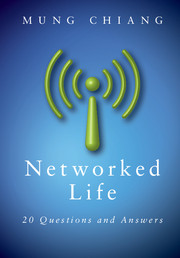Book contents
- Frontmatter
- Contents
- Preface
- Acknowledgements
- Roadmap
- 1 What makes CDMA work for my smartphone?
- 2 How does Google sell ad spaces?
- 3 How does Google rank webpages?
- 4 How does Netflix recommend movies?
- 5 When can I trust an average rating on Amazon?
- 6 Why does Wikipedia even work?
- 7 How do I viralize a YouTube video and tip a Groupon deal?
- 8 How do I influence people on Facebook and Twitter?
- 9 Can I really reach anyone in six steps?
- 10 Does the Internet have an Achilles' heel?
- 11 Why do AT&T and Verizon Wireless charge me $10 a GB?
- 12 How can I pay less for each GB?
- 13 How does traffic get through the Internet?
- 14 Why doesn't the Internet collapse under congestion?
- 15 How can Skype and Bit Torrent be free?
- 16 What's inside the cloud of iCloud?
- 17 IPTV and Netflix: How can the Internet support video?
- 18 Why is WiFi faster at home than at a hotspot?
- 19 Why am I getting only a few % of the advertised 4G speed?
- 20 Is it fair that my neighbor's iPad downloads faster?
- Index
- Notes
2 - How does Google sell ad spaces?
Published online by Cambridge University Press: 05 November 2012
- Frontmatter
- Contents
- Preface
- Acknowledgements
- Roadmap
- 1 What makes CDMA work for my smartphone?
- 2 How does Google sell ad spaces?
- 3 How does Google rank webpages?
- 4 How does Netflix recommend movies?
- 5 When can I trust an average rating on Amazon?
- 6 Why does Wikipedia even work?
- 7 How do I viralize a YouTube video and tip a Groupon deal?
- 8 How do I influence people on Facebook and Twitter?
- 9 Can I really reach anyone in six steps?
- 10 Does the Internet have an Achilles' heel?
- 11 Why do AT&T and Verizon Wireless charge me $10 a GB?
- 12 How can I pay less for each GB?
- 13 How does traffic get through the Internet?
- 14 Why doesn't the Internet collapse under congestion?
- 15 How can Skype and Bit Torrent be free?
- 16 What's inside the cloud of iCloud?
- 17 IPTV and Netflix: How can the Internet support video?
- 18 Why is WiFi faster at home than at a hotspot?
- 19 Why am I getting only a few % of the advertised 4G speed?
- 20 Is it fair that my neighbor's iPad downloads faster?
- Index
- Notes
Summary
A Short Answer
Much of the web services and online information is “free” today because of the advertisements shown on the websites. It is estimated that the online ad industry worldwide reached $94.2 billion in 2012. Compared with traditional media, online advertisements' revenue ranked right below TV and above newspapers.
In the early days of the web, i.e., 1994–1995, online advertisements were sold as banners on a per-thousand-impression basis. But seeing an ad does not mean clicking on it or buying the advertised product or service afterwards. In 1997, GoTo (which later became Overture) started selling advertisement spaces on a per-click basis. This middle ground between ad revenue (what the website cares about) and effectiveness of ad (what the advertisers care about) became a commonly accepted foundation for online advertising.
With the rise of Google came one of the most stable online ad market segments: search ads, also called sponsored search. In 2002, Google started the AdWords service where you can create your ad, attach keywords to it, and send it to Google's database. When someone searches for a keyword, Google will return a list of search results, as well as a list of ads on the right panel, or even the main panel, if that keyword matches any of the keywords of ads in its database. This process takes place continuously and each advertiser can adjust her bids frequently. There are often many ad auctions happening at the same time too. We will skip these important factors in the basic models in this chapter, focusing just on a single auction.
- Type
- Chapter
- Information
- Networked Life20 Questions and Answers, pp. 25 - 43Publisher: Cambridge University PressPrint publication year: 2012



